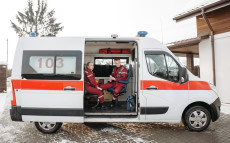- pathfindersAI
- Job Profile
Paramedics
Summary
Paramedics: A Career of Service and Urgency
What They Do
Paramedics are frontline healthcare professionals who provide critical emergency medical care to patients in urgent situations. Often the first on the scene during medical emergencies, they play a pivotal role in assessing a patient's condition and providing life-saving interventions. Whether responding to a car accident, a medical emergency, or a natural disaster, paramedics are trained to manage a wide range of medical situations quickly and efficiently.
Job Responsibilities
Paramedics are entrusted with a variety of responsibilities that require quick thinking and precise execution. Their duties include assessing the immediate medical needs of patients, administering emergency medical treatments such as CPR, defibrillation, wound care, and medication administration. They are also skilled in the use of advanced medical equipment, including ventilators and intravenous lines. Furthermore, paramedics are responsible for safely transporting patients to hospitals or other medical facilities while continuing to provide care en route. Accurate documentation and communication with hospital staff are also key components of the job, ensuring continuity of care for the patient.
Essential Skills
To excel as a paramedic, a combination of technical knowledge and essential soft skills is necessary. Strong critical thinking and problem-solving abilities are paramount, as paramedics must make instant decisions that could mean the difference between life and death. Physical stamina and strength are also important, given the physical demands of the job, such as lifting patients and performing prolonged medical procedures. Excellent communication skills are needed to effectively interact with patients, families, and other healthcare professionals. Emotional resilience and the ability to remain calm under pressure are equally critical, as paramedics often work in high-stress and emotionally turbulent environments.
Educational Pathways
Becoming a paramedic involves rigorous training and education. The journey typically begins with obtaining a high school diploma or equivalent, followed by completing an accredited emergency medical technician (EMT) program. After gaining experience as an EMT, aspiring paramedics must then enroll in a paramedic education program, which is more advanced and can take anywhere from six months to two years to complete, depending on whether it leads to a certificate, diploma, or associate degree. The curriculum includes extensive coursework in anatomy, physiology, pharmacology, and advanced medical procedures, along with hands-on clinical experience. Upon completion of the program, individuals must pass a national or state certifying examination to practice as a licensed paramedic.
Career Prospects
The demand for paramedics is growing, driven by an aging population and the increasing incidence of emergency medical situations. According to the Bureau of Labor Statistics, employment of paramedics and EMTs is projected to grow significantly over the next decade. Advancement opportunities exist for those who wish to further their careers, such as becoming a supervisor, a training officer, or even transitioning into roles in hospital emergency departments or other specialized medical fields. Furthermore, some paramedics choose to further their education and become registered nurses, physician assistants, or emergency management directors, leveraging their front-line medical experience in new capacities.
Conclusion
A career as a paramedic offers a unique blend of excitement, responsibility, and the profound satisfaction of making a tangible difference in people's lives. It requires a specialized set of skills, a dedicated educational pathway, and a commitment to continual learning and emotional resilience. As the demand for emergency medical services continues to grow, those who choose this path will find themselves at the forefront of patient care, providing a critical lifeline in times of urgent need. The role of a paramedic is not just a job; it is a vocation that requires dedication, compassion, and an unwavering commitment to service.
Video
Compensation
| State | Median Salary | Median Hourly | Positions |
|---|---|---|---|
| AL | 44,540 | 21.41 | 1,500 |
| AK | 65,450 | 31.47 | 150 |
| AZ | 49,600 | 23.85 | 2,010 |
| AR | 45,720 | 21.98 | 1,200 |
| CA | 64,400 | 30.96 | 5,370 |
| CO | 62,290 | 29.95 | 2,400 |
| CT | 68,400 | 32.89 | 960 |
| DE | 61,510 | 29.57 | 300 |
| DC | 75,400 | 36.25 | 130 |
| FL | 49,830 | 23.96 | 5,870 |
| GA | 49,360 | 23.73 | 3,720 |
| HI | 75,500 | 36.30 | 130 |
| ID | 53,180 | 25.57 | 380 |
| IL | 53,820 | 25.87 | 4,200 |
| IN | 53,060 | 25.51 | 2,220 |
| IA | 49,930 | 24.01 | 1,200 |
| KS | 45,800 | 22.02 | 1,140 |
| KY | 51,790 | 24.90 | 2,380 |
| LA | 53,370 | 25.66 | 1,930 |
| ME | 53,820 | 25.87 | 520 |
| MD | 63,020 | 30.30 | 1,720 |
| MA | 61,730 | 29.68 | 1,760 |
| MI | 47,800 | 22.98 | 2,970 |
| MN | 65,160 | 31.33 | 1,850 |
| MS | 49,630 | 23.86 | 1,120 |
| MO | 51,260 | 24.64 | 3,500 |
| MT | 48,360 | 23.25 | 360 |
| NE | 53,540 | 25.74 | 480 |
| NV | 58,600 | 28.18 | 970 |
| NH | 58,880 | 28.31 | 400 |
| NJ | 78,790 | 37.88 | 860 |
| NM | 48,930 | 23.53 | 750 |
| NY | 63,650 | 30.60 | 5,880 |
| NC | 48,170 | 23.16 | 4,890 |
| ND | 55,990 | 26.92 | 170 |
| OH | 48,120 | 23.14 | 2,840 |
| OK | 46,610 | 22.41 | 1,450 |
| OR | 70,590 | 33.94 | 980 |
| PA | 51,050 | 24.54 | 4,240 |
| RI | 58,580 | 28.16 | 110 |
| SC | 49,800 | 23.94 | 2,170 |
| SD | 46,250 | 22.24 | 400 |
| TN | 49,550 | 23.82 | 3,860 |
| TX | 52,050 | 25.02 | 9,160 |
| UT | 59,940 | 28.82 | 1,030 |
| VT | 48,590 | 23.36 | 190 |
| VA | 51,950 | 24.98 | 1,750 |
| WA | 98,110 | 47.17 | 2,060 |
| WV | 45,780 | 22.01 | 1,270 |
| WI | 55,180 | 26.53 | 1,670 |
| WY | 50,900 | 24.47 | 220 |
Similar Occupations
In this area you will find other occupations that are close to the one you were viewing in tasks, knowledge and work environment. If the primary job profile you are viewing isn't quite to your liking, take a look around and see what else is available.
Basic and Premium Accounts have more alternative occupations available than the Free account.

Acute Care Nurses - 29-1141.01
Acute Care Nurses provide immediate and intensive care to patients with severe, life-threatening conditions, often working in environments such as emergency rooms, intensive care units, and surgical wards. They monitor vital signs, administer medications, and collaborate with multidisciplinary teams to ensure rapid and effective treatment.
-
$86,070/yr
Median Pay -
3,175,390
Number of Jobs

Ambulance Drivers and Attendants, Except Emergency Medical Technicians - 53-3011.00
Ambulance Drivers and Attendants, Except Emergency Medical Technicians, primarily transport patients to and from healthcare facilities in a non-emergency capacity, ensuring safe and timely arrival. They also assist with patient handling and may provide basic care and comfort during transport.
-
$32,580/yr
Median Pay -
11,520
Number of Jobs